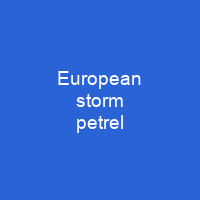The European storm petrel is the only member of the genus Hydrobates. It breeds on islands off the coasts of Europe, with the greatest numbers in the Faroe Islands, United Kingdom, Ireland, and Iceland. The species is thought to have diverged early from the rest of the tubenoses, with specimens from California dating back only to the Late Miocene.
About European storm petrel in brief

It was moved to the genusHydrobates by Friedrich Boie in 1822. The bird is strictly oceanic outside the breeding season, and can find oily edible items by smell. The food is converted in the bird’s stomach to an oily orange liquid, which is regurgitated when the chick is fed. This bird is strongly migratory, spending the Northern Hemisphere winter mainly off the coast of South Africa and Namibia, with some birds stopping in the seas adjoining West Africa, and a few remaining near their Mediterranean breeding islands. Although there is some genetic support for the southern form as a separate species, the morphology is not considered sufficiently different from that of the nominate sub species to justify separate classifying it as a different species. It has a fluttering, bat-like flight, and it lays a single white egg, usually on bare soil, and both adults share the lengthy incubation and both feed the chick. The word stormy is a corruption of pitteral, referring to the bird’s pitter-pattering across the water, and the suggestion that the word refers to St Peter’s walking on the waves is a later invention. The family Hydrobatidae is one of the four major families of the Procellariiformes or \”tubenoses\”, an order of seabirds that also includes the albatrosses, theprocellariidae, andThe diving petrels.
You want to know more about European storm petrel?
This page is based on the article European storm petrel published in Wikipedia (as of Nov. 08, 2020) and was automatically summarized using artificial intelligence.







